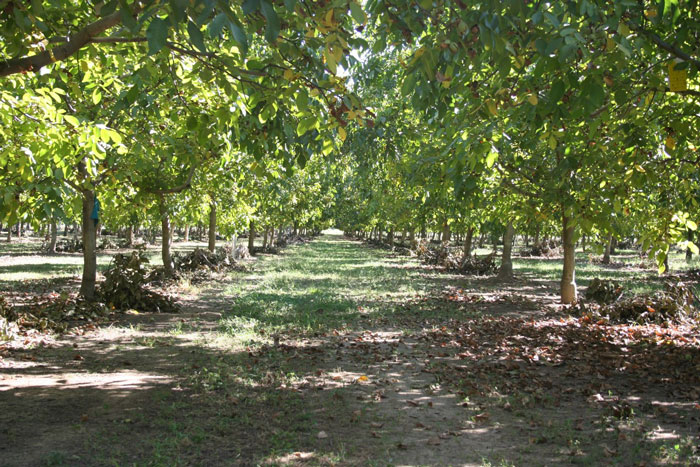September 2, 2015

Although a survey of commercial English walnut orchards has found that walnut twig beetle (WTB) and the fungal disease it spreads are scattered throughout the Central Valley production region, researchers say there is no need to panic.
Instead, they suggest that growers monitor trees for thousand cankers disease (TCD) symptoms, which includes branch dieback, crown thinning, tiny beetle holes, or staining.
Tree removal should not be considered unless considerable decline is found.
“Just finding a couple of holes with some small cankers especially if you're not seeing symptoms like branch dieback doesn’t mean take the tree out,” said Janine Hasey, University of California Cooperative Extension farm adviser for Yuba, Sutter, and Colusa counties.
“Trees can have TCD and they’re still OK. It’s not like chestnut blight which comes in and takes out every tree. Black walnut is a different story.”
The tiny WTB burrows into walnut trees creating galleries under the bark to lay its eggs. WTB is a concern since it can carry the fungus Geosmithia morbida that causes TCD.
The quarter-sized cankers, which grow and may coalesce over time, are typically found around beetle entry sites.
The fungus kills the phloem tissue in the tree, initially causing branch death near the infection site. As the disease progresses, additional branches can die, the crown can thin, and eventually the trunk is attacked. The tree then dies.
Although researchers acknowledge that black walnuts are highly susceptible to TCD, the question still remains about the disease’s impact on commercially-grown English walnuts.
A three-year project funded through a National Institute of Food and Agriculture specialty crop block grant hopes to answer this question. The study will examine how widespread the beetle and TCD are in the state’s commercial walnut orchards, the disease severity, beetle flight habits, and other issues.
Steve Seybold, research entomologist with the U.S. Forest Service in Davis, Calif., traps beetles in seven orchard locations from Lake to Tulare counties to try to determine when the insect is the most active.
“The beetle really flies year round except for possibly December and January. Even then, they’ll fly when temperatures exceed 65-70 degrees,” he said.
Based on these results, Seybold says growers should remove diseased trees between December and February when the beetle is the least active. It’s a good idea to grind or burn wood debris that could harbor beetles and the fungus.
Hasey is co-leading the UCCE portion of the TCD orchard surveys with Richard Bostock of the UC Davis’ plant pathology department.
Farm advisers and members of Bostock’s lab have examined commercial walnut orchards in Yuba, Sutter, Colusa, Contra Costa, Lake, San Joaquin, Stanislaus, Tulare, and Kings counties. By the end of this fall, they hope to examine orchards in San Benito, Merced, Glenn, Tehama, and Butte counties.
When possible, orchards have been selected for proximity to black walnuts to determine whether the beetle and disease are radiating out from the wild hosts, Hasey says. Orchards at least five-years-old on Paradox rootstock were chosen due to disease susceptibility.
Surveyors considered the disease incidence and rated the trees for disease severity.
Hasey says an analysis of the initial survey results by Mohammad Yaghmour of the Bostock lab found TCD more prevalent in the southern end of the San Joaquin Valley, followed by the Yolo-Solano-Yuba-Sutter area. In most orchards, the disease level was relatively low.
“We found that the disease is not really as high in most cases as we thought it might be, and often the trees with low severity are actually fine,” she said.
“With the higher severity, that’s when you start to see some dieback or trees dying. It appears they can tolerate some infection overall, at least this is what we’ve found so far.”
TCD is often found in trees already in decline or weakened by other stressors, including other diseases or incorrect irrigation. Hasey says these trees should be removed.
In a separate but related project, Seybold, associate project scientist Yigen Chen, and graduate students Stacy Hishinuma and Jackson Audley are conducting an experiment on four rows of the Chandler walnut variety at the Nickels Estate near Arbuckle to compare how walnut trees with and without crown gall respond to beetle feeding and TCD.
The project goal is to quantify how the pest complex affects nut production, Seybold says.
The three-year study, funded by the California Walnut Board, began earlier this year with the team marking and recording every beetle hole in the trees. They will monitor the insect’s movement and distribution in and around the orchard over a period of time.
In this study, Bruce Lampinen, UCCE specialist in nut tree canopy management, will monitor the water potential of the trees, canopy light interception, nut harvest weights, and nut quality.
You May Also Like




